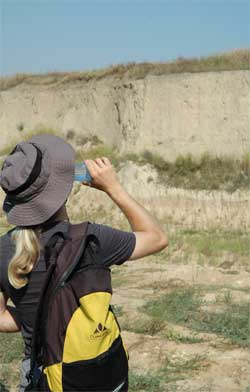LOESSFEST'09 | Aug. 31st – Sept. 3rd, 2009 |Novi Sad-Serbia
Potential of Quartz and Feldspar in OSL to Date Middle Pleistocene Loess From the Eifel Area – A Comparison with Independent Age Control
Zeeden, C.1,2, Hambach,U.1, Nowaczyk, N.3, Hark, M.1
1Chair of Geomorphology, University Bayreuth, Germany
2Stratigraphy and Paleontology, University Utrecht, The Netherlands
3GeoForschungsZentrum Potsdam, Germany
 Various sediments may record properties of the Earth’s magnetic field during
or short after deposition. In this study we use the directional component of the
palaeosecular variation (change of the magnetic field direction observed at a given
point on the Earth’s surface) signal as recorded by loess to compare this signal
to reference data – here the Lac du Bouchet (France) record. We correlate features
of the declination and inclination, and obtain ages from this comparison.
Using this comparison, we construct a high resolution chronology of the investigated
loess-paleosol sequence containing archaeological remains. At the archaeological
“Willendorf II” site near the village of Willendorf in Austria a high resolution
palaeomagnetic study was conducted in order to use the existing datings (14C
and luminescence) to gain a palaeomagnetic signal from loess with good age control
and to check whether palaeosecular variation features may be identified and
2) compare this signal to well dated reference section(s) and to improve the existing
age control this way. The locality was chosen due to its already existing good
age control, and due to its high aeolian deposition rates of ca. 12 cm/kyr in average.
The loess and loess like sediments are not homogeneous, loess is intercalated
with bleached and humiferous horizons.
Various sediments may record properties of the Earth’s magnetic field during
or short after deposition. In this study we use the directional component of the
palaeosecular variation (change of the magnetic field direction observed at a given
point on the Earth’s surface) signal as recorded by loess to compare this signal
to reference data – here the Lac du Bouchet (France) record. We correlate features
of the declination and inclination, and obtain ages from this comparison.
Using this comparison, we construct a high resolution chronology of the investigated
loess-paleosol sequence containing archaeological remains. At the archaeological
“Willendorf II” site near the village of Willendorf in Austria a high resolution
palaeomagnetic study was conducted in order to use the existing datings (14C
and luminescence) to gain a palaeomagnetic signal from loess with good age control
and to check whether palaeosecular variation features may be identified and
2) compare this signal to well dated reference section(s) and to improve the existing
age control this way. The locality was chosen due to its already existing good
age control, and due to its high aeolian deposition rates of ca. 12 cm/kyr in average.
The loess and loess like sediments are not homogeneous, loess is intercalated
with bleached and humiferous horizons.
The comparison of the palaeosecular variation data with data from the Lac du
Bouchet works well, and we imply that European loess geoarchives may record
palaeosecular variation features with high resolution, even if loess is pedogenically
altered. The palaeosecular variation pattern of loess is successfully employed to
compare and this way indirectly date the loess exposure on millennial-scale temporal
resolution.



